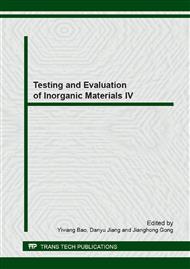p.224
p.228
p.232
p.236
p.240
p.245
p.249
p.253
p.258
Comparative Study on Preparation and Properties of BaZr0.8Y0.2O3-δ Solid Electrolyte
Abstract:
The preparation of the BaZr0.8Y0.2O3-δ solid electrolyte obtained by a nitrate-citrate combustion is reported. This synthesis method is compared with solid state reaction. The phase formation process was studied using thermogravimetric analysis (TGA) and differential scanning calorimetry (DSC). The phase evolution during the gel-combustion process and solid state process as a function of heat-treatment temperature was also studied by X-ray powder diffraction (XRD). When using nitrate-citrate combustion method a pure phase was formed at 800°C, which is much lower than that of conventional solid state reaction (at 1200°C). The sinterability of electrolyte powder was also investigated. At 1700°C very dense pellets can be obtained for both samples. The conductivity of BaZr0.8Y0.2O3-δ (BZY20) electrolyte prepared using two different processes was measured by AC impedance spectroscopy. Impedance spectra analyses showed that the grain boundary conductivity is much lower than that of the bulk for BZY20. Furthermore, the grain-boundary resistance of the BZY20 prepared via nitrate-citrate combustion process was reduced markedly compared to that of the BZY20 prepared by conventional solid state reaction.
Info:
Periodical:
Pages:
240-244
Citation:
Online since:
November 2013
Authors:
Price:
Сopyright:
© 2014 Trans Tech Publications Ltd. All Rights Reserved
Share:
Citation:


